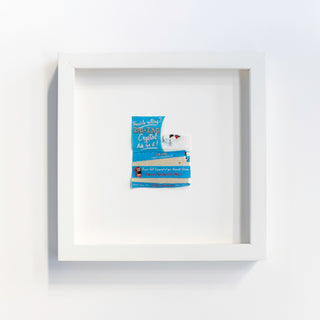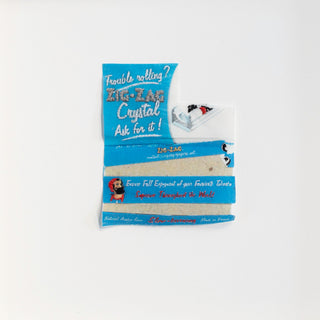Jay Hutchinson - Blue Zig Zag 9
About the Artwork: A limited edition of 9 hand-embroidered works made exclusively for Fiksate Gallery! Each is digitally printed and then hand-stitched. Some are sanded and stressed to create a street-worn appearance, some are left crisp and fresh. Jay Hutchinson's art makes you look again. It takes the throwaway, literally, and raises it to a level where it is no longer worthless. Using as his subject discarded scraps and rubbish found on his daily journeys, he recreates the items and reinvents them as intricate and attractive embroidered pieces. This allows us to appreciate that even the detritus of everyday life can have its own surprising and subversive beauty.
About the Artist: Jay Hutchinson is a New Zealand artist based in Dunedin. He graduated from the Dunedin School of Art with an MFA in 2008 and worked with numerous mediums including hand-embroidery, performance, drawing, video, and fabric construction. His most recent projects have explored product fetishism, the devaluation of the worker and our decaying economic system.
Hutchinson is interested in the archaeology of the discarded, forgotten, and thrown away.
His meticulously embroidered objects reflect the indulgences of 21st-century society – seductive yet destructive consumables such as fast food, tobacco, and confectionery.
Hutchinson uses the methodologies of archaeology and art to subvert the hierarchy of objects and in labouring over the rejected, his work confuses the boundaries between treasure and trash. In elevating debris his work acts as a rejection of romance – which is closely tied to the myths of both the artist and the archaeologist. In popular fiction both are cast as glamourous figures, when the reality of both careers requires copious and sometimes tedious amounts of time spent researching, writing proposals, networking, and finally making or working in the field.
All of the items are found by Hutchinson on foot, their importance being in their discovery in transitory spaces. These streets and alleyways are democratic sites in which anyone can move and exist – and leave behind their trace. Just as it is for an archaeologist, context is central to this artist’s process. Each item is documented in situ, then carefully removed (when possible), cleaned, and preserved for study and reproduction.
But what do they mean now that they exist within the white walls of the gallery? In this new context, they become artifacts of contemporary culture – evidence of this critical moment when capitalism and climate change have become sources of existential dread.
Jay Hutchinson - Blue Zig Zag 9
About the Artwork: A limited edition of 9 hand-embroidered works made exclusively for Fiksate Gallery! Each is digitally printed and then hand-stitched. Some are sanded and stressed to create a street-worn appearance, some are left crisp and fresh. Jay Hutchinson's art makes you look again. It takes the throwaway, literally, and raises it to a level where it is no longer worthless. Using as his subject discarded scraps and rubbish found on his daily journeys, he recreates the items and reinvents them as intricate and attractive embroidered pieces. This allows us to appreciate that even the detritus of everyday life can have its own surprising and subversive beauty.
About the Artist: Jay Hutchinson is a New Zealand artist based in Dunedin. He graduated from the Dunedin School of Art with an MFA in 2008 and worked with numerous mediums including hand-embroidery, performance, drawing, video, and fabric construction. His most recent projects have explored product fetishism, the devaluation of the worker and our decaying economic system.
Hutchinson is interested in the archaeology of the discarded, forgotten, and thrown away.
His meticulously embroidered objects reflect the indulgences of 21st-century society – seductive yet destructive consumables such as fast food, tobacco, and confectionery.
Hutchinson uses the methodologies of archaeology and art to subvert the hierarchy of objects and in labouring over the rejected, his work confuses the boundaries between treasure and trash. In elevating debris his work acts as a rejection of romance – which is closely tied to the myths of both the artist and the archaeologist. In popular fiction both are cast as glamourous figures, when the reality of both careers requires copious and sometimes tedious amounts of time spent researching, writing proposals, networking, and finally making or working in the field.
All of the items are found by Hutchinson on foot, their importance being in their discovery in transitory spaces. These streets and alleyways are democratic sites in which anyone can move and exist – and leave behind their trace. Just as it is for an archaeologist, context is central to this artist’s process. Each item is documented in situ, then carefully removed (when possible), cleaned, and preserved for study and reproduction.
But what do they mean now that they exist within the white walls of the gallery? In this new context, they become artifacts of contemporary culture – evidence of this critical moment when capitalism and climate change have become sources of existential dread.




